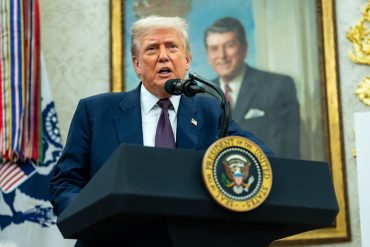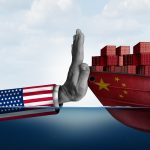
- Global Trade
- Tariffs
- Trade Policy
Trump Launches Tariff Offensive: 100% on Chips, 25% on India
5 minute read

Semiconductor industry faces supply chain disruption as Trump’s tariffs target Asian manufacturers and pressure India-US trade relations
Key Takeaways
- Trump imposes 100% semiconductor tariffs and 25% additional tariffs on India, bringing total Indian tariffs to 50% and creating significant pressure on trade relationships.
- Asian markets show mixed performance despite Wall Street gains with South Korea’s KOSPI jumping 1.6% and Japan’s Nikkei rising 0.6%, while India’s Sensex falls 0.5% on trade tensions.
- Asia-Pacific tech investments surge 20% in 2025 driven by AI adoption and digital transformation, with companies like Raytron Technology posting 26.72% earnings growth.
Introduction
Asian markets navigate conflicting signals as President Trump’s escalating tariff threats weigh against Wall Street’s overnight gains and robust regional tech sector performance. The administration’s announcement of 100% tariffs on imported semiconductors and additional 25% tariffs on India creates fresh uncertainty for global trade flows.
Markets across the region display mixed reactions, with technology stocks leading gains in several countries while trade-sensitive sectors face pressure. The divergent performance reflects investors’ attempts to balance immediate policy risks against underlying economic fundamentals and corporate earnings strength.
Key Developments
Trump announces sweeping trade measures targeting semiconductor imports and Indian trade relationships. The 100% tariff on imported semiconductors exempts only U.S.-manufactured products, while India faces additional 25% tariffs.
The semiconductor tariffs represent one of the most aggressive trade actions targeting a critical technology sector. Combined with existing trade measures, India now faces 50% total tariffs, marking one of the highest rates imposed on a major trading partner.
Simultaneously, trade data from Australia exceeds expectations as June trade surplus strengthens due to export recovery and reduced imports. Investors await China’s July trade balance figures, which will provide crucial insights into U.S. tariff impacts on Chinese exports.

Market Impact
Regional equity markets demonstrate resilience despite trade tensions. South Korea’s KOSPI jumps 1.6% to 3,198.00, while Japan’s Nikkei 225 gains 0.6% to 40,549.54. Hong Kong’s Hang Seng rises 0.7% to 24,902.53, and Shanghai Composite surges 1% to 3,617.60.
India’s Sensex emerges as the primary casualty, declining 0.5% on trade tension concerns. The country’s Nifty 50 futures show modest 0.1% gains following the central bank’s rate hold decision, suggesting cautious optimism among investors.
European markets open higher, with Germany’s DAX gaining 0.6% and Britain’s FTSE 100 advancing 0.4%. U.S. futures indicate continued momentum, with S&P 500 futures up 0.2% following Apple’s $100 billion U.S. manufacturing investment announcement.
Strategic Insights
The semiconductor tariff strategy aims to accelerate domestic manufacturing while pressuring global supply chains. This creates immediate challenges for technology companies reliant on Asian semiconductor production, potentially benefiting U.S. manufacturers and reshoring initiatives.
India’s position creates a complex geopolitical dynamic between energy security priorities and trade relationships. The government emphasizes continued Russian oil purchases for energy security, setting up a direct confrontation with U.S. trade policy objectives.
Technology sector fundamentals remain strong across Asia despite trade uncertainties. Companies demonstrate robust financial performance, with earnings growth averaging 17.5% across the regional tech cohort, suggesting underlying business momentum continues.
Expert Opinions and Data
“Trump’s threats of ‘substantial’ tariff hikes on account of imports of Russian crude pose a quagmire for India,” Mizuho Bank states. “Between exacerbated U.S.-imposed geo-economic headwinds and financial/macro setbacks from Russian oil advantages lost, pain will be hard to avert.”
The optimism about Apple’s $100 billion investment plan in U.S. manufacturing helped drive Wednesday’s market gains, demonstrating investor appetite for domestic manufacturing initiatives.
Technology investment data shows Asia-Pacific tech spending projected to grow 20% in 2025, with AI and digital transformation driving expansion. Leading firms like Raytron Technology execute share buybacks worth ¥100 million, signaling management confidence despite market volatility.
Regional performance metrics reveal strong corporate fundamentals, with Ningbo Zhenyu Technology reporting 496.6% year-on-year earnings growth and maintaining 38.1% insider ownership, indicating long-term strategic commitment from management teams.
Conclusion
Asian markets demonstrate resilience against escalating trade tensions while technology sector fundamentals remain robust. The divergence between policy uncertainty and corporate performance creates opportunities for selective investment strategies focused on domestic-oriented businesses and technology leaders.
Trade data releases from China and Australia this week will provide critical indicators for assessing tariff impacts on regional export dynamics. Market attention shifts to how companies adapt supply chains and strategic positioning in response to evolving trade policies.








